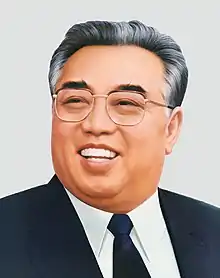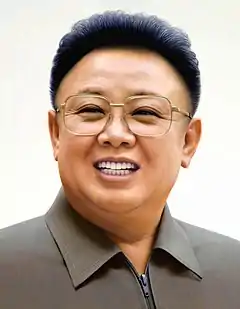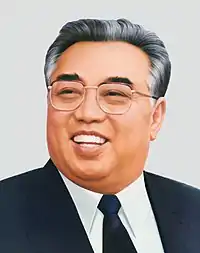Kim Il-sung and Kim Jong-il portraits
Visual depictions of Kim Il-sung have been commonplace in North Korea since the 1940s following the example of Joseph Stalin in the Soviet Union and Mao Zedong in China. The display of Kim Il-sung portraits was made mandatory at homes in the 1970s. Gradually, they have become mandatory in certain public places as well, such as factories, airports, railway stations, and rail and subway carriages. Portraits of Kim Jong-il have been hung next to Kim Il-sung since the late 1970s. A portrait of Kim Jong-un was displayed for the first time in public in 2018.
Rules regarding the placement and maintenance of the portraits are complex and change frequently. At homes, they should be placed on the most prominent wall in the living room with nothing else on it, at high and looking downwards. Of importance, and subject to random checks, is that they are kept clean, a responsibility that usually falls on the lady of the house.
History


.jpg.webp)
Since the 1940s visual depictions of Kim Il-sung have been commonplace in North Korea.[1] The practice was adopted from Stalin portraits in the Soviet Union and portraits of Mao Zedong in China.[2] Displaying a portrait of Kim Il-sung in every house became mandatory in the 1970s. The state distributed such portraits and instructed people to display them in their living rooms.[1] By Kim Il-sung's 60th birthday in 1972, North Korea had more leader portraits than the Soviet Union or China ever did.[2] In 1972, the compulsory display of the portraits was extended to all factories, airports, and railway stations.[1]
At the end of the decade, North Koreans were told to hang portraits of Kim Jong-il next to their portraits of Kim Il-sung.[1] The regulation was put in place relatively late into Kim Jong-il's cult of personality.[3] The reason was that he had little, and by 1980 virtually no, competition as the heir apparent.[4] The order to do so became unofficially so that North Korean propaganda could claim that there was a spontaneous movement that supported Kim Jong-il. By around 1980, every office and home had the two portraits on display.[5] In the 1980s, the rules on portraits were extended yet again to cover rail and subway carriages. Buses and trams were excluded for unknown reasons.[1] Since the early 1990s, Kim Jong-il portraits have been the same size as those depicting Kim Il-sung, and their display has been standardized so that they are always displayed side by side.[2] In the 1990s, a third kind of portrait was added that depicts Kim Jong-il and Kim Il-sung engaged in discussion about state management. High-ranking officials were given yet another portrait, that of Kim Il-sung's first wife and mother of Kim Jong-il, Kim Jong-suk. Offices, however, do not display this picture.[1] In recent years, the portraits' societal importance has waned.[6]
The image of Kim Il-sung underwent changes as he aged and according to political currents: early portraits from the 1960s have him in a Mao suit, while those from the 1980s depict him in a Western suit. Years after his death, he began to appear in the military uniform of Taewonsu (generalissimo). Images of Kim Jong-il, too, went from Mao suit to the Taewonsu uniform.[2] Under Kim Jong-un, the appearances of the portraits have become increasingly standardized.[7] A portrait of Kim Jong-un was displayed for the first time in public in November 2018 during a visit of Cuban president Miguel Díaz-Canel to Pyongyang.[8]
Andrei Lankov, an expert on North Korea, notes that the set of rules regarding the portraits changes frequently, making it "remarkable for its constant fluidity".[9]
Display
Today, the portraits are found everywhere in North Korea.[2] Rules regarding the display and maintenance of the portraits are complex.[5] The portraits should be hung on the most prominent wall of the apartment with nothing else on it,[10] preferably in the living room.[2] They must be kept clean and may not be hung off-center.[11] Any disrespect to the images of the leaders is criminal. This includes not only portraits hung on walls but also e.g. images in newspapers.[12] Damage to the portraits leads to an investigation and, if the suspect is found guilty, punishment.[5] A penalty of one day of hard labor at a construction site is reported for failure to properly hang the portraits.[6] The portraits are to be protected even in the case of an emergency.[13] Still, neglecting care for the portraits is considered a rather minor offense, and as such, it is a typical confession that people make during mutual criticism sessions.[14] Random checks for the portraits are carried out,[9] monthly at least during Kim Il-sung's reign,[15] but the inminban (neighborhood watch) sometimes tips people off of inspections.[6]
When a North Korean changes apartment, he or she must start by hanging the portraits first.[9] The portraits are usually hung on a wall with nothing else, placed high, and looking downwards. Some families bow to the portraits every morning and in the evening,[12] saying greetings,[16] even though bowing to them is not mandatory even in public places.[10] When a North Korean family mourns a dead member, ceremonial greetings and offerings are made to the deceased, but only after the two portraits have been given the same treatment.[16] The portraits are usually kept clean by adults in the house, typically the mother of the family. They wipe the glass every morning. Sometimes the portraits have a box under them that houses a white cloth used for dusting them that one is not allowed to use for any other purpose.[16][12]
In addition to homes, offices, factories, shops, hospitals, classrooms and libraries sport the portraits,[12] as do decks of ships and fronts of trains.[10] In public buildings they are placed above the main entrances.[2] All portraits are made by the Mansudae Art Studio. They are glazed and framed with timber.[2]
Safekeeping
Stories about North Koreans saving leader portraits from certain destruction have been sported in North Korean media for decades,[5] and they have also been disseminated by the inminban.[17] For instance, in 2007 it was reported that a factory worker rescued his leader portraits and his five-year-old daughter from a flooded house. When he was overpowered by the water, he let go of his daughter but managed to hold onto the portraits.[13] Such a feat can rise the societal status of a person considerably by improving his or her songbun (ascribed social rank in North Korea).[18] Saving portraits is based on an arbitrary interpretation of the Ten Principles for the Establishment of a Monolithic Ideological System.[17]
Special portraits
In addition to the standardized portraits, there have been special cases. One of these is a gift from the Syrian Arab Republic, a portrait of Kim Il-sung that is entirely made up of Arabic calligraphy of his work The Non-Aligned Movement is a Mighty Anti-Imperialist Revolutionary Force of Our Times, housed at the International Friendship Exhibition.[19] The largest Kim Il-sung portrait, at least in Pyongyang, was 15 by 11 meters and was hung at the Pyongyang Department Store No. 1 in the 1990s.[2]
See also
References
- Lankov 2015, p. 35.
- Lankov 2007, p. 26.
- Cha 2012, p. 79.
- Cha 2012, pp. 79, 87.
- Lankov 2015, p. 53.
- Do et al. 2015, p. 238.
- "Slogans of the 'Glorious Country' mass games, in pictures". NK News. 13 September 2018. Retrieved 15 September 2018.
- "North Korea puts Kim Painting on Show for the first time". Channel NewsAsia. 6 November 2018. Retrieved 18 November 2018.
- Lankov 2007, p. 27.
- Hunter, Helen-Louise (1999). Kim Il-song's North Korea. Westport: Praeger Publishers. p. 16. ISBN 978-0-275-96296-8.
- Cha 2012, p. 8.
- Portal 2005, p. 87.
- Lankov 2015, p. 36.
- Lankov 2015, pp. 42–44.
- Senker, Cath (2012). North Korea and South Korea. New York: The Rosen Publishing Group. p. 12. ISBN 978-1-4488-6072-2.
- Kwon, Heonik; Chung, Byung-Ho (2012). North Korea: Beyond Charismatic Politics. Lanham: Rowman & Littlefield Publishers. p. 143. ISBN 978-1-4422-1577-1.
- Do et al. 2015, p. 237.
- Lankov 2015, p. 44.
- Portal 2005, p. 95.
Works cited
- Cha, Victor (2012). The Impossible State: North Korea, Past and Future. London: Random House. ISBN 978-1-4481-3958-3.CS1 maint: ref=harv (link)
- Do, Kyung-ok; Kim, Soon-am; Han, Dong-ho; Lee, Keum-soon; Hong, Min (2015). White Paper on Human Rights in North Korea 2015 (PDF). Seoul: Korea Institute for National Unification. ISBN 978-89-8479-802-1. Archived from the original (PDF) on 20 February 2018.
- Lankov, Andrei (2007). North of the DMZ: Essays on Daily Life in North Korea. Jefferson: McFarland. ISBN 978-0-7864-5141-8.CS1 maint: ref=harv (link)
- — (2015). The Real North Korea: Life and Politics in the Failed Stalinist Utopia. Oxford: Oxford University Press. ISBN 978-0-19-939003-8.CS1 maint: ref=harv (link)
- Portal, Jane (2005). Art Under Control in North Korea. London: Reaktion Books. ISBN 978-1-86189-236-2.CS1 maint: ref=harv (link)
External links
| Wikimedia Commons has media related to |



